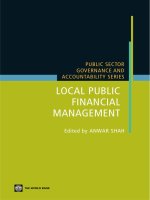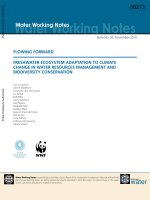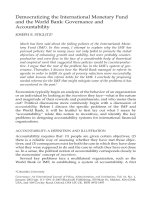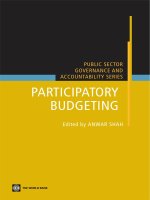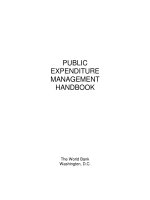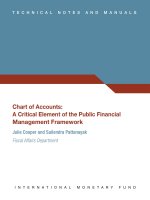Public fincnail management and accountability
Bạn đang xem bản rút gọn của tài liệu. Xem và tải ngay bản đầy đủ của tài liệu tại đây (690.31 KB, 58 trang )
Public Financial Management
and Accountability
Governance Induction
Hitchin 9th March 2004
What do we want to get out of it?
A clearer understanding of the public financial
management and accountability framework
Some understanding of diagnostic instruments and
the harmonisation agenda
Taking the work forward
Know when to ask for expert help and support
Calling for more!!
What do we want to get out of it?
What is our vision…What are we aiming for?
Where are we now…Diagnostics and drivers for
change
Moving on…Addressing the basics and strategic
incrementalism
Know when to ask for expert help and support
Calling for more!!
What is PFMA?
Process by which decisions are made,
implemented and accounted for
amount of resources to be spent
balance between revenue and expenditure
allocation of funds between entities /activities
how resources will be managed and accounted for
(emphasis on substantive outcomes)
(covers the whole of the budget cycle)
(covers broad institutional and managerial arrangements)
Vision..What are we aiming for?
Effective, transparent and accountable public
financial management systems that will translate
clearly defined development priorities into the
effective delivery of public goods and services
Country ownership consistent with evolving
international standards, regular progress
measurement supported by coherent donor support
Overall fiscal discipline, allocative efficiency
and value for money
Why is PFMA important?
Sound management of all public finances are intrinsically
important to development
Transparency about how public resources are raised and then
used is basic to democratic accountability
Improvements can lead to big changes which benefit the poor
(viz Uganda education)
Off budget expenditure financed by donors undermines
accountability
Active scrutiny by legislature and public is essential
Risk to service delivery of poor PFM systems (see WDR 2004)
Improvements in PFM reduce opportunities for corruption (see
WDR 2004)
Where are we now?
Evidence shows that these systems are in very
poor shape in many of our partner countries
Assessment of accounting in countries receiving
direct budget support from DFID
No country met the proposed minimum standard
IMF/WB review of HIPC countries 2002(2001)
Little upgrading = 0 (2)
Significant upgrade = 8 (7)
Substantial upgrade = 14 (16)
Lets look at the system
Reporting and
audit
Policy review
Strategic
planning
Accounting and
monitoring
Budget
execution
Budget
preparation
Lets look at the system again
Accountant General
Auditor General
Reporting and
audit
Policy review
Ministry of
Development/
Economic Planning
Strategic
planning
Accounting and
monitoring
Budget
execution
Ministry of Finance
Budget
preparation
Accounting &
Monitoring
Budget
Execution
Potential disconnects
1
Policy
review
Planning Process
5
4
Auditor General Accountant General’s
Department
6
Ministry of Finance
3
Reporting and auditing
2
Budget
preparation
Strategic
planning
The Budget Cycle and Risk
Where can risk occur?
The budget cycle
Reporting and
audit
Policy review
Strategic
planning
Accounting and
monitoring
Budget
execution
Budget
preparation
Introduction of Risk
Risk occurs at each stage and in the connections between the
stages
Reporting and
audit
Policy review
Strategic
planning
Accounting and
monitoring
Budget
execution
Budget
preparation
Is the Budget Cycle flawed?
Does Policy review feed into Strategic Planning?
Does Strategic Planning inform Budget
preparation?
Is the Budget executed?
Is expenditure accounted and monitored? (who
does it and who for?)
Is resource use audited?
Does audit information feed into policy review?
Risk identification
The broader governance framework
Does the budget translate strategies into
resource allocation?
Budget composition
Budget execution
Different perspectives by the players
The broader Governance framework
Level of political engagement in medium term expenditure
plans/poverty strategies
Institutional links between planning and finance
Executive involvement in setting resource allocation
priorities
Adherence to the “rules of the game”
A budget law specifying fiscal management responsibilities
Independent scrutiny of government expenditures
Overall Government capacity to design and implement a
reform programme
The Budget as an instrument of
translation
Consistency of resource allocation decisions with
overall plans and strategies
What use is made of a medium term framework?
Relationship of the discretionary budget to overall
government expenditure?
Is expenditure linked with objectives and priorities
Are there adequate estimates of the costs of
delivering on policies?
The composition of the budget
Are all Government activities included in
the budget?
Are all sources of revenue captured?
What is the role of extra budgetary funds?
Are there separate earmarked funds?
Consistency between the recurrent and
capital budgets
Budget execution
Are funds disbursed in a timely and consistent
way?
What is the relationship between the budget and
the expenditure outturn?
Can they be compared?
Is there a history of cash constraints and
expenditure cut backs?
Do ceilings change during the budget preparation
process?
Summary of the Risks
Little accountability for the use of public
resources (Diversion and corruption)
Strategies are not translated into resource
allocations
Funded ministries do not deliver Public
services
Poor value for money
Having said all of that
How can we build up a shared understanding of
the problem?
What experiences do we have of constructive
dialogue?
A twin track…delivering “quick wins” based on a
jointly owned and developed longer term strategic
plan.
Engagement of both politicians and bureaucrats.
Different perceptions of risk
Implications for Diagnosis(1)
Moving away from accounting for transactions to a focus
on systems improvement
The country is the focus for support
Diagnostic tools must capture the breadth of the agenda
(technical, institutional and wider governance
considerations)
Too many products and not enough attention to the process
Diagnosis must lead to a reform programme which can be
monitored
Implications for Diagnosis(2)
Review the diagnostic part of the DFID
PEM guidelines
Working collaboratively with others CFAA,
PER, CPAR, ROSC, etc
Adding value in terms of breadth
Awareness of the integration agenda
Considerable work going on by PEFA (see
Handout)
Diagnosis
Using the benchmarks within DFID’s
Fiduciary Risk Framework
A clear set of rules governs the
budget process
A budget law
specifying fiscal
management
responsibilities is in
operation
Accounting policies
and account code
classifications are
published and applied
Applicability of the
budget law
Clarifies roles and
responsibilities
Link between the budget
and planning frameworks
Realistic budget timetable
Clear budget guidelines
Consistency with IMF
definitions
“Formal” v “Informal”
